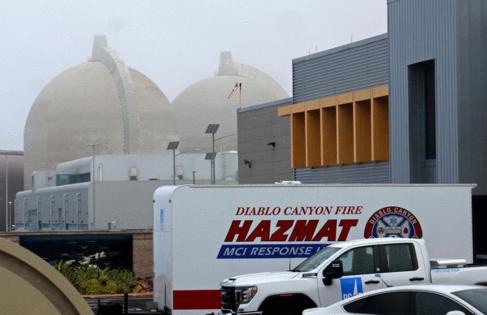California's last nuclear plant is poised to stave off extinction
Published in News & Features
California’s last-running nuclear plant barely escaped extinction in 2022. The cost of operating it has become a source of tension amid a worsening affordability crisis. And the state has a moratorium on new nuclear power.
Yet, the Diablo Canyon plant — in many ways a relic of yesteryear — is primed for a 20-year extension, coinciding with the age of AI. The reason is simple enough: the state needs electricity.
Tech giants are desperately searching for clean, round-the-clock power for their data centers. Electric vehicles and new factories are also adding strain to grids, as are increasingly intense heat waves that can send demand soaring.
PG&E Corp., the utility giant and Diablo Canyon’s operator, has already begun the process for the plant’s extension. The plant completed a U.S. Nuclear Regulatory Commission review. The fate of its two licenses now rests with the California Coastal Commission — an agency PG&E has a fraught history with — and the state water board. Diablo Canyon will need to prove it can operate in a safe and cost-effective manner without taking a major toll on the local environment.
“My near-term hope is that Diablo will run its full 20-year renewed license,” says Maureen Zawalick, PG&E’s vice president of business and technical services. “So we are laser-focused on that mission.”
Diablo Canyon began operations in 1985, and parts of it are still stuck in time. In the control room, buttons and dials reign supreme over digital screens.
“Operators don’t like change,” says simulation engineer Brian Sawyer.
The plant also has an exact replica of the control room where reactor operators learn how to handle everything from earthquakes to terrorist attacks. Sawyer presses a button to simulate an earthquake, sending a rumble through the training room via a 30-inch subwoofer under the stairs as lights begin flashing. This type of training is so crucial to keeping the plant functioning that Diablo Canyon’s nuclear operators spend every fifth week — about 20% of their careers — running through these simulations.
That way, they’ll be ready if the Big One comes, Sawyer says. In the event of a large earthquake, the plant can shut down its two reactors in two seconds, he explains. Operators are also on guard against wildfires.
During a visit in early August, smoke from the Gifford Fire had Unit 2 running at a reduced output. Smoke can lower conductivity and cause arcing on power lines, so two of the three lines were de-energized as a precautionary measure, explains PG&E Senior Director Tom Jones.
Diablo Canyon’s reactors are entombed in concrete and sit in separate buildings adjacent to the structure that houses the turbines and generators for both of the plant’s reactors. That cavernous space is the size of two-and-a-half football fields and is accessible only after a lengthy screening process that includes passing through what’s colloquially called a “puffer machine,” which uses blasts of air to collect and analyze microscopic particles. Exiting the plant is just as involved, requiring a radiation scan.
These protocols are intended to keep the site secure and the 1,200 PG&E employees working there safe. They also help protect the 1,100 contractors brought in to refuel the reactors. All of these factors and more are considered in the relicensing process.
Nuclear reactors are staying online or being restarted, such as Three Mile Island, reflecting the industry’s changing fortunes. Utilities are racing to meet growing demand as tech companies agree to pay a premium for nuclear power. That will drive a 63% increase in U.S. nuclear capacity by mid-century, according to Bloomberg Intelligence projections. While the trend buoys the idea that Diablo Canyon will be able to renew all its licenses, PG&E has yet to ink a data center deal. And there remain some important hurdles to renewal.
One is related to the water the plant needs to operate. Nuclear power plants are often built near large bodies of water used for cooling purposes. In Diablo Canyon’s case, the large body of water in question is the Pacific Ocean, and the plant withdraws 2 million gallons a minute or 2.5 billion gallons a day.
While PG&E says it expects to get these approvals in the first quarter of 2026, the California Coastal Commission has requested additional information from the utility, according to Joshua Smith, the agency’s public information officer. (The commission’s former senior scientist dubbed Diablo Canyon California’s largest marine predator because its intake system traps copious ocean larvae.)
“The Coastal Commission is dedicated to a thorough review of the coastal resource impacts of PG&E’s project. California prides itself on the protection of its marine environment, and this situation is no exception,” said Smith. “The commission believes a path forward is possible given the ongoing cooperation of the investor-owned utility.”
The plant witnessed tens of thousands of protestors and the largest number of arrests in the history of the anti-nuclear movement in the years leading up to its opening. The proposed Diablo Canyon extension is also facing resistance from critics of nuclear power. Chief among those concerns: radioactive waste.
Every operational cycle, the plant’s spent fuel is transferred to two stainless steel canisters surrounded by a foot of concrete, each of which is 350,000 pounds fully loaded. Altogether, the utility holds 70 spent fuel canisters onsite, stored above-ground next to the plant’s raw water reservoir. The canisters are strong and could withstand a locomotive charging at them at 20 miles per hour, Jones says.
Diablo Canyon’s operating costs are also a point of contention. When California legislators voted to keep the plant open in 2022, Governor Gavin Newsom authorized a $1.4 billion loan. At the time, the expectation was that PG&E would repay it using an anticipated federal loan or profits from operations from 2029 to 2030. But as much as $588 million of those funds are unlikely to come in, according to nonprofit outlet CalMatters.
Altogether, PG&E forecasts that the plant will cost $1.4 billion to run in 2026. The utility expects to make $935 million selling the plant’s power through California’s electricity market, leaving ratepayers on the hook for the remaining $410 million after incorporating fees.
PG&E maintains that there will be a net benefit for its ratepayers, after taking into account the excess energy it generates for the state to meet customer demand.
Even with the state’s moratorium on new nuclear power in California, PG&E’s Zawalick points out that the power plant’s original design has space for six units and 60 years of spent fuel.
“I would love to see more nuclear built in the U.S., including California,” she says.
©2025 Bloomberg L.P. Visit bloomberg.com. Distributed by Tribune Content Agency, LLC.







Comments